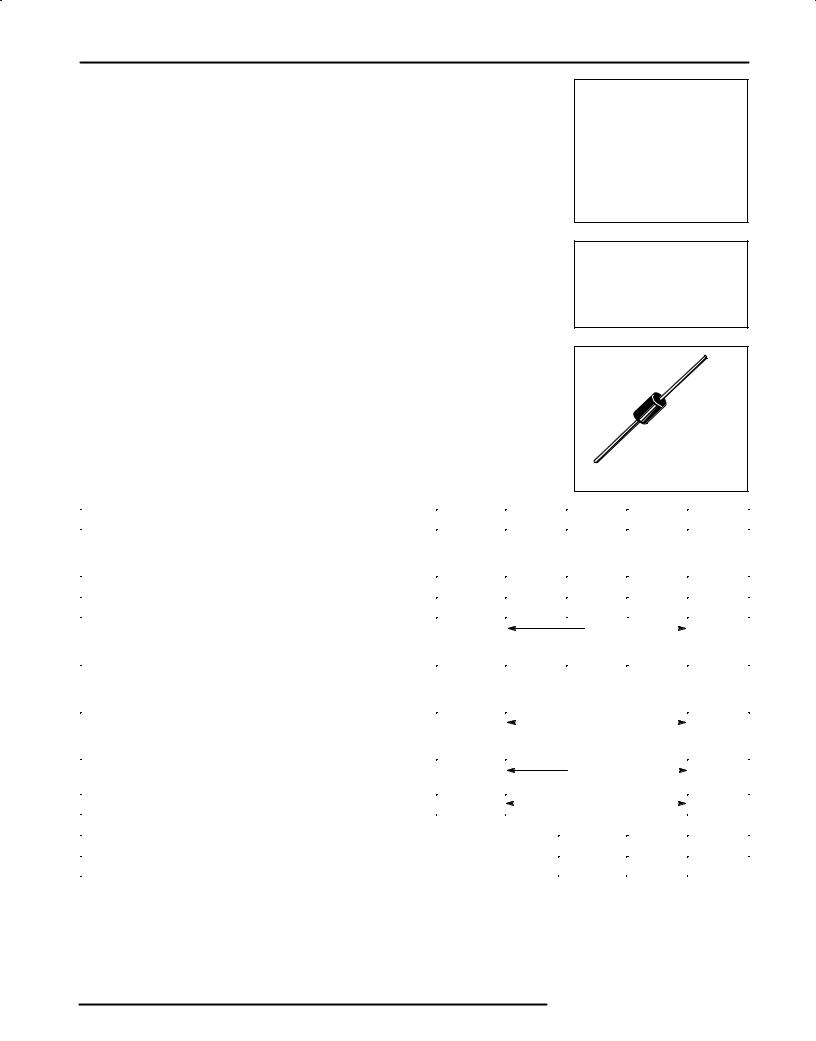Motorola 1N5822, 1N5820, 1N5821 Datasheet

MOTOROLA
SEMICONDUCTOR TECHNICAL DATA
Order this document by 1N5820/D
Designer's Data Sheet
Axial Lead Rectifiers
. . . employing the Schottky Barrier principle in a large area metal±to±silicon power diode. State±of±the±art geometry features chrome barrier metal, epitaxial construction with oxide passivation and metal overlap contact. Ideally suited for use as rectifiers in low±voltage, high±frequency inverters, free wheeling diodes, and polarity protection diodes.
•Extremely Low vF
•Low Power Loss/High Efficiency
•Low Stored Charge, Majority Carrier Conduction
Mechanical Characteristics:
•Case: Epoxy, Molded
•Weight: 1.1 gram (approximately)
•Finish: All External Surfaces Corrosion Resistant and Terminal Leads are Readily Solderable
•Lead and Mounting Surface Temperature for Soldering Purposes: 220°C Max. for 10 Seconds, 1/16″ from case
•Shipped in plastic bags, 5,000 per bag
•Available Tape and Reeled, 1500 per reel, by adding a ªRL'' suffix to the part number
•Polarity: Cathode indicated by Polarity Band
•Marking: 1N5820, 1N5821, 1N5822
MAXIMUM RATINGS
1N5820
1N5821
1N5822
1N5820 and 1N5822 are Motorola Preferred Devices
SCHOTTKY BARRIER
RECTIFIERS
3.0 AMPERES
20, 30, 40 VOLTS
CASE 267±03
PLASTIC
Rating |
Symbol |
1N5820 |
|
1N5821 |
|
|
1N5822 |
Unit |
||||||
|
|
|
|
|
|
|
|
|
|
|
|
|
|
|
Peak Repetitive Reverse Voltage |
VRRM |
20 |
|
|
30 |
|
|
|
|
40 |
|
V |
||
Working Peak Reverse Voltage |
VRWM |
|
|
|
|
|
|
|
|
|
|
|
|
|
DC Blocking Voltage |
VR |
|
|
|
|
|
|
|
|
|
|
|
|
|
Non±Repetitive Peak Reverse Voltage |
VRSM |
24 |
|
|
36 |
|
|
|
|
48 |
|
V |
||
RMS Reverse Voltage |
VR(RMS) |
14 |
|
|
21 |
|
|
|
|
28 |
|
V |
||
Average Rectified Forward Current (2) |
IO |
|
|
3.0 |
|
|
|
|
|
|
|
A |
||
|
|
|
|
|
|
|
|
|
||||||
VR(equiv) v 0.2 VR(dc), TL = 95°C |
|
|
|
|
|
|
|
|
|
|
|
|
|
|
(RqJA = 28°C/W, P.C. Board Mounting, see Note 2) |
|
|
|
|
|
|
|
|
|
|
|
|
|
|
Ambient Temperature |
TA |
90 |
|
|
85 |
|
|
|
|
80 |
|
°C |
||
Rated VR(dc), PF(AV) = 0 |
|
|
|
|
|
|
|
|
|
|
|
|
|
|
RqJA = 28°C/W |
|
|
|
|
|
|
|
|
|
|
|
|
|
|
Non±Repetitive Peak Surge Current |
IFSM |
|
|
80 (for one cycle) |
|
|
|
A |
||||||
|
|
|
|
|
||||||||||
(Surge applied at rated load conditions, half wave, single phase |
|
|
|
|
|
|
|
|
|
|
|
|
|
|
60 Hz, TL = 75°C) |
|
|
|
|
|
|
|
|
|
|
|
|
|
|
Operating and Storage Junction Temperature Range |
TJ, Tstg |
|
|
|
*65 to +125 |
|
|
|
|
°C |
||||
|
|
|
|
|
|
|
||||||||
(Reverse Voltage applied) |
|
|
|
|
|
|
|
|
|
|
|
|
|
|
|
|
|
|
|
|
|
|
|
|
|
|
|
|
|
Peak Operating Junction Temperature (Forward Current applied) |
TJ(pk) |
|
|
|
150 |
|
|
|
|
|
|
|
°C |
|
|
|
|
|
|
|
|
|
|
|
|||||
*THERMAL CHARACTERISTICS (Note 2) |
|
|
|
|
|
|
|
|
|
|
|
|
|
|
|
Characteristic |
Symbol |
Max |
Unit |
|
|
|
|
|
Thermal Resistance, Junction to Ambient |
RqJA |
28 |
°C/W |
|
(1) |
Pulse Test: Pulse Width = 300 ms, Duty Cycle = 2.0%. |
|
|
|
(2) |
Lead Temperature reference is cathode lead 1/32″ from case. |
|
|
|
* Indicates JEDEC Registered Data for 1N5820±22.
Designer's Data for ªWorst Caseº Conditions Ð The Designer's Data Sheet permits the design of most circuits entirely from the information presented. SOA Limit curves Ð representing boundaries on device characteristics Ð are given to facilitate ªworst caseº design.
Preferred devices are Motorola recommended choices for future use and best overall value.
Rev 2
Rectifier Device Data
Motorola, Inc. 1996

1N5820 |
1N5821 |
1N5822 |
|
|
|
|
|
*ELECTRICAL CHARACTERISTICS (TL = 25°C unless otherwise noted) (2) |
|
|
|
|
|||
|
|
|
|
|
|
|
|
|
|
Characteristic |
Symbol |
1N5820 |
1N5821 |
1N5822 |
Unit |
|
|
|
|
|
|
||
Maximum Instantaneous Forward Voltage (1) |
VF |
|
|
|
V |
||
(iF = 1.0 Amp) |
|
|
0.370 |
0.380 |
0.390 |
|
|
(iF = 3.0 Amp) |
|
|
0.475 |
0.500 |
0.525 |
|
|
(iF = 9.4 Amp) |
|
|
0.850 |
0.900 |
0.950 |
|
|
Maximum Instantaneous Reverse Current @ Rated dc Voltage (1) |
iR |
|
|
|
mA |
||
TL = 25°C |
|
|
|
2.0 |
2.0 |
2.0 |
|
TL = 100°C |
|
|
20 |
20 |
20 |
|
|
(1)Pulse Test: Pulse Width = 300 ms, Duty Cycle = 2.0%.
(2)Lead Temperature reference is cathode lead 1/32″ from case.
* Indicates JEDEC Registered Data for 1N5820±22.
NOTE 1 Ð DETERMINING MAXIMUM RATINGS
Reverse power dissipation and the possibility of thermal runaway must be considered when operating this rectifier at reverse voltages above 0.1 VRWM. Proper derating may be accomplished by use of equation (1).
TA(max) = TJ(max) * RqJAPF(AV) * RqJAPR(AV) (1) where TA(max) = Maximum allowable ambient temperature
TJ(max) = Maximum allowable junction temperature
(125°C or the temperature at which thermal runaway occurs, whichever is lowest)
PF(AV) = Average forward power dissipation PR(AV) = Average reverse power dissipation
RqJA = Junction±to±ambient thermal resistance
Figures 1, 2, and 3 permit easier use of equation (1) by taking reverse power dissipation and thermal runaway into consideration.
The figures solve for a reference temperature as determined by equation (2).
TR = TJ(max) * RqJAPR(AV) |
(2) |
Substituting equation (2) into equation (1) yields: |
|
TA(max) = TR * RqJAPF(AV) |
(3) |
Inspection of equations (2) and (3) reveals that TR is the ambient temperature at which thermal runaway occurs or where TJ = 125°C, when forward power is zero. The transition from one boundary condition to the other is evident on the curves of Figures 1, 2, and 3 as a difference in the rate of change of the slope in the vicinity of 115°C.
The data of Figures 1, 2, and 3 is based upon dc conditions. For use in common rectifier circuits, Table 1 indicates suggested factors for an equivalent dc voltage to use for conservative design, that is:
VR(equiv) = V(FM) F |
(4) |
The factor F is derived by considering the properties of the various rectifier circuits and the reverse characteristics of Schottky diodes.
EXAMPLE: Find TA(max) for 1N5821 operated in a 12±volt dc supply using a bridge circuit with capacitive filter such that IDC = 2.0 A
(IF(AV) = 1.0 A), I(FM)/I(AV) = 10, Input Voltage = 10 V(rms), RqJA =
40°C/W.
Step 1. Find VR(equiv). Read F = 0.65 from Table 1,
NVR(equiv) = (1.41) (10) (0.65) = 9.2 V. Step 2. Find TR from Figure 2. Read TR = 108°C
@ VR = 9.2 V and RqJA = 40°C/W.
Step 3. Find PF(AV) from Figure 6. **Read PF(AV) = 0.85 W
I(FM)
@ I(AV) + 10 and IF(AV) + 1.0 A.
Step 4. Find TA(max) from equation (3).
TA(max) = 108 * (0.85) (40) = 74°C.
**Values given are for the 1N5821. Power is slightly lower for the 1N5820 because of its lower forward voltage, and higher for the 1N5822. Variations will be similar for the MBR±prefix devices, using PF(AV) from Figure 7.
Table 1. Values for Factor F
|
|
|
|
|
Full Wave, |
|
Circuit |
Half Wave |
Full Wave, Bridge |
Center Tapped*² |
|||
|
|
|
|
|
|
|
Load |
Resistive |
Capacitive* |
Resistive |
Capacitive |
Resistive |
Capacitive |
|
|
|
|
|
|
|
Sine Wave |
0.5 |
1.3 |
0.5 |
0.65 |
1.0 |
1.3 |
|
|
|
|
|
|
|
Square Wave |
0.75 |
1.5 |
0.75 |
0.75 |
1.5 |
1.5 |
|
|
|
|
|
|
|
*Note that VR(PK) [ 2.0 Vin(PK). ²Use line to center tap voltage for V in.
2 |
Rectifier Device Data |
